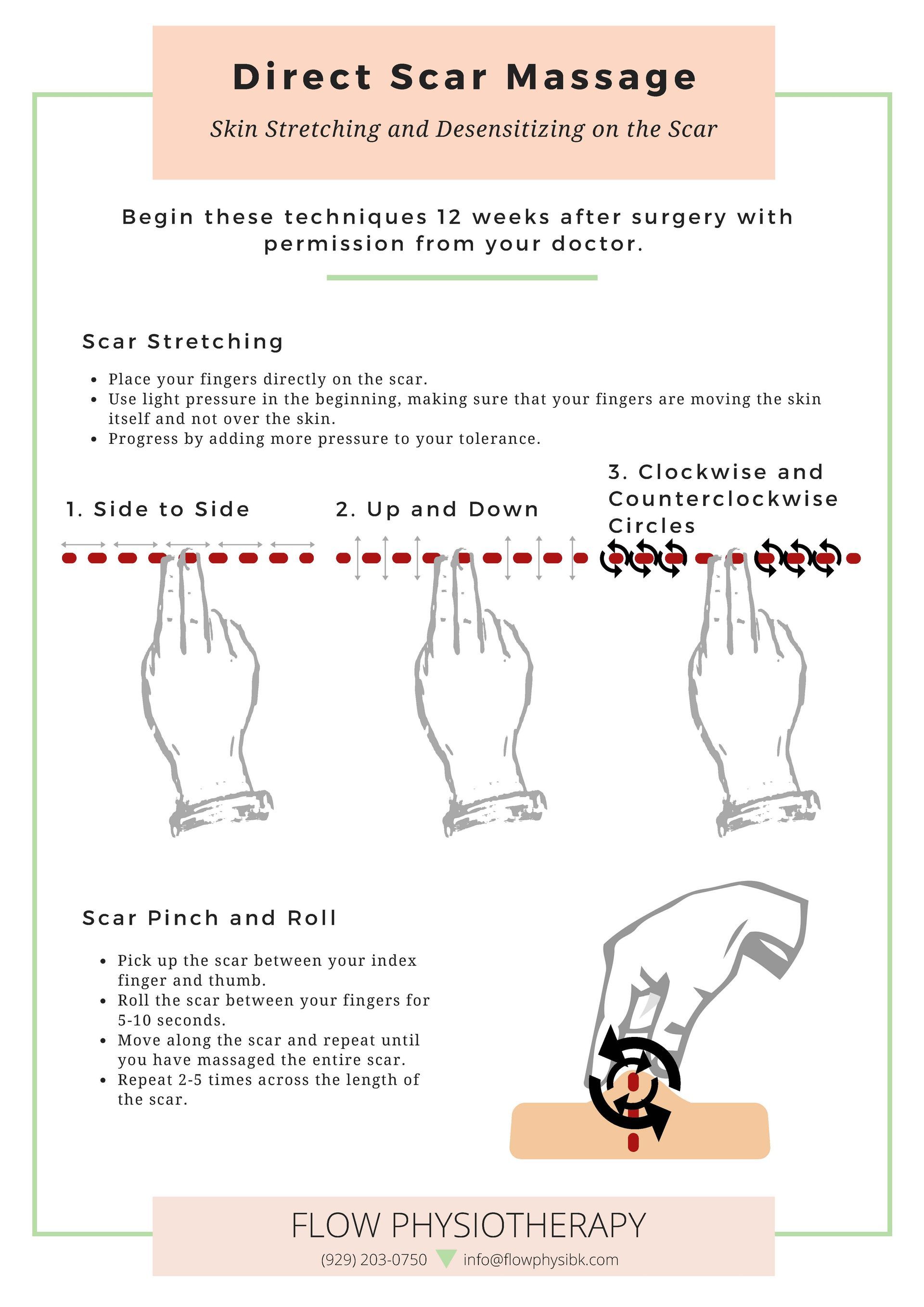C-Section Massage Handout
Author name

Your perineum is the space between the vulvar opening and the anus. In this space there are muscles, connective tissue, and skin that oftentimes can become restricted or “tight”. In this article, you will learn who will benefit from this technique, how to perform, and several modifications to tailor it best to your needs.

Pelvic floor physical therapy can play a significant role in postpartum recovery. After giving birth, many women experience a variety of physical challenges, such as pelvic floor dysfunction, lower back pain, or abdominal muscle separation, also known as diastasis recti. Following your 6-week appointment with your obstetrician or midwife, a pelvic floor physical therapist can help provide you with a tailored plan with exercises and treatments to help you feel like the best version of yourself. Symptoms You May be Experiencing: Urinary incontinence: frequency, leaking and/or urgency Bowel dysfunction: constipation and/or loss of control of gas or stool Pelvic floor heaviness Pelvic pain, lower back pain or hip pain Navigating return to or pain with sex Diastasis recti Muscle weakness and fatigue How Physical Therapy Can Help Restoring Muscular Strength and Flexibility: Pregnancy places significant strain on the muscles and ligaments as the body adapts to accommodate the growing baby. After childbirth, many women experience weakened core muscles, especially the abdominal and pelvic floor muscles. Physical therapists employ targeted exercises and techniques to gradually rebuild muscle strength and improve flexibility. This not only aids in restoring prepregnancy fitness levels but also helps in preventing long-term musculoskeletal issues Addressing Pelvic Floor Dysfunction: One of the most common postpartum issues women face is pelvic floor dysfunction, which can manifest as urinary incontinence, pelvic pain, or discomfort during intercourse. Physical therapists specialize in pelvic floor rehabilitation, offering exercises such as Kegels and biofeedback therapy to strengthen these muscles. Through personalized treatment plans, we help mothers regain control and function of their pelvic floor, enhancing comfort and quality of life. Managing Pain and Healing: Childbirth often leaves women with residual pain, particularly in the lower back, hips, and abdomen. Physical therapists utilize therapeutic techniques such as manual therapy and movement to alleviate pain and promote healing. These interventions are tailored to each woman’s specific needs, ensuring a holistic approach to recovery. Providing Tailored Guidance with Return to Exercise: Many women struggle to figure out how to appropriately return to exercise while avoiding injury. Physical therapists specialize in helping you create a safe and effective exercise plan that will help you regain your strength and get back to the things you love. Empowering Mothers for the Journey Ahead Postpartum recovery is a gradual process that requires patience and personalized care. By addressing physical challenges early on, physical therapy can prevent long-term complications and foster a quicker recovery. Whether it’s regaining core strength, managing pain, or enhancing pelvic health, we are here to help equip you with the tools you need to thrive as you embark on this new chapter of motherhood.

Introduction Pregnancy is an exhilarating journey, filled with anticipation, joy, and challenges. Among these challenges, physical discomfort can significantly impact a woman's overall experience. Fortunately, prenatal physical therapy is a remarkable solution that can help manage these challenges, making the journey towards motherhood smoother and more enjoyable. This blog post will delve into the role of prenatal physical therapy, its benefits, and how it can optimize your birthing experience. What is Prenatal Physical Therapy? Prenatal physical therapy is a specialized form of treatment aimed at addressing the physical changes a woman's body undergoes during pregnancy. It focuses on preventing and alleviating pregnancy and postpartum-related discomforts such as back pain, pelvic pain, urinary incontinence, and breathing limitations. Although this can look differently for everyone, we generally recommend an initial assessment in the first trimester to develop a tailored plan of care for you. One of the most important benefits for you will be the education and guidance on building strength to better manage the postural changes your body will experience during pregnancy. Prenatal physical therapists can help provide pain relief through manual therapy, education and exercise. And lastly, in the third trimester, you will be able to learn and practice breathing techniques, birthing positions and gain additional insight about how to best optimize your birthing experience. Benefits of Prenatal Physical Therapy Prenatal physical therapy can significantly improve the quality of a woman's life during pregnancy. It provides relief from common pregnancy-related discomforts, enhances physical stamina, and improves overall health and well-being. The exercises designed to strengthen the pelvic floor muscles can help reduce labor The Role of Prenatal Physical Therapy in Optimizing Your Birthing Experience 2 time, facilitate a more comfortable delivery process, and speed up postpartum recovery. Additionally, this therapy can help manage stress and anxiety, promoting mental wellness during this crucial time. Prenatal Physical Therapy and the Birthing Experience The birthing experience is a unique one, and every woman deserves to have it as smooth and comfortable as possible. Prenatal physical therapy plays a crucial role in achieving this. By strengthening the body and alleviating discomfort, it helps women stay active and flexible, which can aid in a smoother delivery. It also equips them with breathing and relaxation techniques that can be immensely beneficial during labor. Furthermore, the education provided about posture and movement can help women reduce strain and injury during the birthing process. Takeaway In conclusion, prenatal physical therapy can be a game-changer in a woman's pregnancy journey, enhancing her overall well-being and optimizing the birthing experience. It is a holistic approach that addresses both physical and emotional aspects, helping women to enjoy this beautiful journey while preparing them for the grand finale – the arrival of their little one. If you're expecting, consider incorporating prenatal physical therapy into your prenatal care routine. Remember, a healthier and happier pregnancy paves the way for a smoother and more fulfilling birthing experience.


